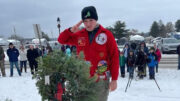Early blooming native trees provide many benefits to the landscape and our native pollinators.
The unfolding of spring after a long winter can make us anxious for early blooming plants, but we are not the only ones who are looking forward to early flowers. Our native pollinators rely on these blooms as an important food source. While we might first think of herbaceous perennials as food sources for pollinators, early-blooming native trees are also excellent nectar sources. These trees help satisfy pollinators' need for carbohydrates, which they use to fuel activities like foraging and nest construction. They can support our pollinators in another way, too, by providing a food source for native butterfly and moth larvae. The larvae of most native butterflies and moths have very specific diets, and the plants that they require are referred to as host plants. Many of our native trees are host plants for as many as 120 different species of butterflies and moths.
Consider adding one of these native trees to your landscape. Within each species, you will find different varieties and cultivars to choose from. These may vary in bloom and fall leaf color. They might also vary in size and habit, as some of these trees have dwarf or weeping varieties. Some cultivars provide disease resistance. Once you choose the tree species you want to add to your landscape, it is worth taking the time to look at different varieties and cultivars to be sure you get the right tree for your location and the color, size, and habit you most desire.
Here are some suggestions.
Red maples ( Acer rubrum ) are among the first trees to flower, and even though their flowers are not large or showy, they still provide nectar for our pollinators. Hardy in USDA zones 2 to 9, this easy-to-grow member of the soapberry family ( Sapindaceae ) grows from 40 to 120 feet tall with a spread of 30 to 50 feet. Appearing before their leaves, their red flowers grow in short-stemmed, hanging clusters. Male and female flowers appear either on separate branches of the same tree or on separate trees. Red maple is a host plant for the imperial moth.
Serviceberry ( Amelanchier spp.), a member of the rose family ( Roseaceae ), can be grown as a large, multi-trunked shrub or a small tree, reaching heights up to 15 feet. Its common name refers to the timing of its spring blooms, which coincided with when the ground usually thawed enough for burials and funeral services. Hardy in USDA zones 4 to 9 will grow in full sun to full shade, but those grown in full sun will have the best fruit production. Serviceberry forms root suckers that will naturally cause the plant to form a small shrub-like colony. To grow as a tree, it must be pruned, which is best done in the fall to avoid excessive loss of sap. The five-petaled, white flowers grow in clusters and typically bloom in mid-March to early April before the emergence of their leaves. While their flowers usually last only for about a week, they are a nectar source for bees and other pollinators. These are followed by edible berry-like fruits that mature to a dark, purplish black pomme 2 to 3 months after they bloom. Serviceberry is a host plant for over 120 species of moth and butterfly larvae.
Black cherry ( Prunus serotina ), another member of the rose family ( Roseaceae ), is a later blooming option. Hardy, in USDA zones 2 to 8, prefers full sun. If left untrimmed, it grows 60 to 80 feet tall but can be grown as a shrub by cutting it to the ground every 2 to 3 years. Coinciding within the emergence of its foliage, drooping clusters of small, fragrant, five-petaled, white flowers, 3 to 6 inches long, appear in late April to May. Round, dark purple fruit follow the flowers and mature in late summer. All parts of the plant are toxic except for the fruit. Black cherry is a larval host plant for several butterfly species, including the coral hairstreak, eastern swallowtail, spring azure, and viceroy.
Eastern redbud ( Cercis canadensis ), a member of the pea family ( Fabaceae ), is a small understory tree that will grow up to 30 feet tall and 20 to 30 feet wide. Its bright pink flowers, blooming as early as March, before the leaves appear, can be found at the edges of woodland areas throughout Pennsylvania. Hardy in USDA zones 4 to 9 prefers being in partial shade to full sun. When planting, give special consideration to site selection, as redbuds do not tolerate root disturbance. Five-petaled flowers, similar in appearance to other members of the pea family, are 1⁄2 inch wide and grow in clusters of four to eight on leaf axils, branches, and even the trunk. By late summer, flat 2 to 4-inch-long seed pods follow the blooms. Bees, butterflies, and other insects feed on the nectar, but only long-tongued bees reach the nectar-producing structures of the flower. Eastern redbud is a larval host plant for twelve butterfly species.
Flowering dogwood ( Benthamidia florida ) is a small understory tree that grows 15 to 25 feet tall. Like the eastern redbud, it grows at the edges of woodland areas throughout Pennsylvania. Hardy in USDA zones 5A to 9B, it will grow in full sun to part shade. You might be familiar with the four white or pink notched petals that appear before their leaves in March through May. These are not flowers at all but are 2-inch long bracts or modified leaves. The true flowers of this dogwood species are found in the center of the bracts and are small and greenish-yellow. Despite their small size, these true flowers support many specialized bees. Glossy, bright-red, oval fruit follows in the fall and is eaten by birds and mammals such as chipmunks, black bear, foxes, skunks, and squirrels. Flowering dogwood is a host plant for the spring azure butterfly.
This educational blog is a series of informative articles from the Penn State Master Gardeners volunteers plus news concerning the group and their activities. For more information, click here.
































